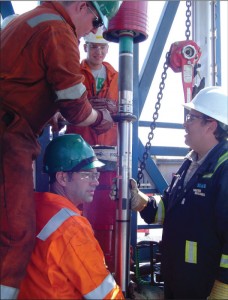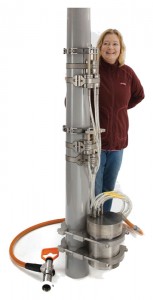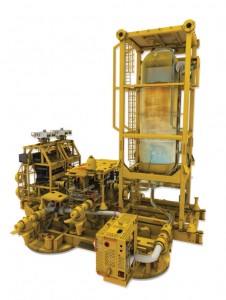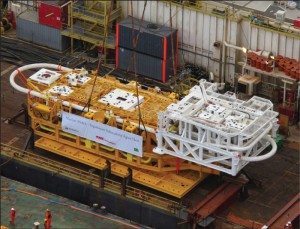2012 OTC Spotlight on New Technology Awards
The Offshore Technology Conference has announced the 13 winning technologies that will receive the 2012 Spotlight on New Technology Awards recognizing innovative technologies significantly impacting offshore exploration and production.
Winning technologies are selected based on five criteria:
• New: The technology must be less than two years old.
• Innovative: The technology must be original, groundbreaking and capable of revolutionizing the offshore E&P industry.
• Proven: The technology must be proven, either through full-scale application or successful prototype testing.
• Broad interest: The technology must have broad interest and appeal for the industry.
• Significant impact: The technology must provide significant benefits beyond existing technologies.
Baker Hughes’ TeleCoil downhole communication system maximizes the efficiency of coiled tubing (CT) interventions by assuring depth accuracy while optimizing the operational effectiveness of downhole processes. System flexibility also enables CT-conveyed, real-time electric logging and perforating applications. By integrating intervention and logging operations, equipment and personnel are minimized on location.
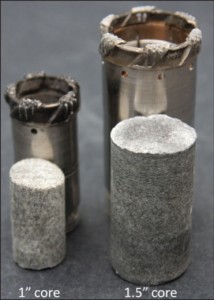 Baker Hughes has introduced an innovative rotary sidewall coring service, MaxCOR. It acquires sidewall cores that are 225% more volume per unit length, enhancing accuracy of reservoir rock and fluid analysis. MaxCOR enables operators to more efficiently and effectively evaluate complex reservoirs to maximize hydrocarbon recovery.
Baker Hughes has introduced an innovative rotary sidewall coring service, MaxCOR. It acquires sidewall cores that are 225% more volume per unit length, enhancing accuracy of reservoir rock and fluid analysis. MaxCOR enables operators to more efficiently and effectively evaluate complex reservoirs to maximize hydrocarbon recovery.
The ClampOn Subsea Corrosion-Erosion Monitor provides real-time measurement and monitoring of wall thickness loss in pipes and other metal structures. The non-intrusive instrument can be retrofitted or pre-installed on the outside of a pipe to provide pipe wear rates over entire sections up to 2 meters in length.
 The Dockwise Vanguard is an innovative and the largest semi-submersible vessel built. At 275 meters (902 ft) long and 70 meters (230 ft) wide, the Vanguard can carry 110,000 tones and travel across oceans at 14 knots. Virtually all of the space on deck is clear and available for cargo. The vessel has been designed by Dockwise for both the dry-transport and the offshore dry-docking market. Delivery is planned by Q4 2012.
The Dockwise Vanguard is an innovative and the largest semi-submersible vessel built. At 275 meters (902 ft) long and 70 meters (230 ft) wide, the Vanguard can carry 110,000 tones and travel across oceans at 14 knots. Virtually all of the space on deck is clear and available for cargo. The vessel has been designed by Dockwise for both the dry-transport and the offshore dry-docking market. Delivery is planned by Q4 2012.
FMC Technologies’ Pazflor is the first full-scale green field development with subsea separation and boosting to produce two different grades of hydrocarbons from four independent reservoirs. The system enables economic development of a reservoir that could not have been developed utilizing conventional subsea production systems.
Marlim SSAO, developed by Petrobras and FMC Technologies, will debottleneck the floating production facility and increase production by removing unwanted water from the production stream at the seabed. This system will also be the first to use water re-injection to increase reservoir pressure and boost production.
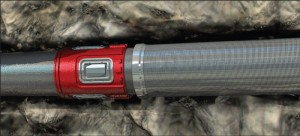 Halliburton’s EquiFlow, an autonomous inflow control device, is a simple, reliable device with no moving parts that improves completion reliability and efficiency by smoothing production throughout the interval, delaying water and gas breakthrough, greatly reducing water and gas production after breakthrough, and increasing ultimate recovery from the well.
Halliburton’s EquiFlow, an autonomous inflow control device, is a simple, reliable device with no moving parts that improves completion reliability and efficiency by smoothing production throughout the interval, delaying water and gas breakthrough, greatly reducing water and gas production after breakthrough, and increasing ultimate recovery from the well.
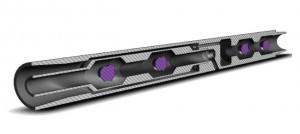 Reelwell Downhole Isolation System (RDIS) provides double barrier elements for use in a dual drill string (DDS) arrangement. The RDIS enables unlimited number of open/close operations providing downhole isolation of the well whenever required. RDIS provides a unique solution for improving safety and reliability during DDS drilling operations.
Reelwell Downhole Isolation System (RDIS) provides double barrier elements for use in a dual drill string (DDS) arrangement. The RDIS enables unlimited number of open/close operations providing downhole isolation of the well whenever required. RDIS provides a unique solution for improving safety and reliability during DDS drilling operations.
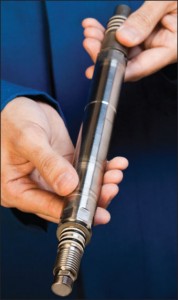 The high-resolution ultra high-pressure, high-temperature Schlumberger Signature Quartz Gauges provide precise, reliable pressure measurements in the most extreme environments. Utilizing ceramic multichip components bonded onto a single substrate, the gauges can withstand pressures up to 30,000 psi at temperatures of 410°F (210°F), while delivering high-resolution pressure measurements at recording rates as fast as 0.1 sec.
The high-resolution ultra high-pressure, high-temperature Schlumberger Signature Quartz Gauges provide precise, reliable pressure measurements in the most extreme environments. Utilizing ceramic multichip components bonded onto a single substrate, the gauges can withstand pressures up to 30,000 psi at temperatures of 410°F (210°F), while delivering high-resolution pressure measurements at recording rates as fast as 0.1 sec.
The PowerDrive Archer high-build rate rotary steerable (RSS) system from Schlumberger delivers well profiles previously possible only with motors, yet with the rate of penetration and wellbore quality of a fully rotating RSS. It has repeatedly and consistently delivered high build rates, at times over 17°/100 ft, which can maximize reservoir exposure, reduce risk and increase potential hydrocarbon production.
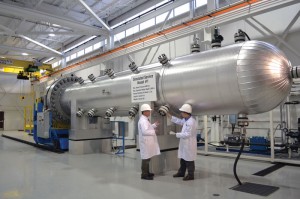 ShawCor’s new Simulated Service Vessel (SSV) is the industry’s largest and most advanced deepwater test chamber for end-to-end thermal insulation systems, capable of simulating water depths to 3,000 meters and temperatures to 356°F (180°C). With real-time data acquisition, the SSV validates the long-term integrity of any subsea insulation system.
ShawCor’s new Simulated Service Vessel (SSV) is the industry’s largest and most advanced deepwater test chamber for end-to-end thermal insulation systems, capable of simulating water depths to 3,000 meters and temperatures to 356°F (180°C). With real-time data acquisition, the SSV validates the long-term integrity of any subsea insulation system.
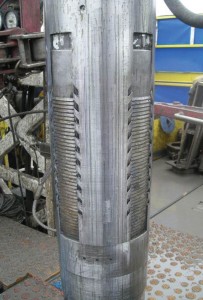 Tesco’s patented Liner Drilling System enables the simultaneous drilling of a directional wellbore and running of the liner in a single trip with the option to set the liner in tension anywhere in the parent casing and the ability to retrieve the bottomhole assembly without having to pull the liner the surface.
Tesco’s patented Liner Drilling System enables the simultaneous drilling of a directional wellbore and running of the liner in a single trip with the option to set the liner in tension anywhere in the parent casing and the ability to retrieve the bottomhole assembly without having to pull the liner the surface.
 The Claw is a subsea grappling device used in conjunction with Versabar’s VB 10,000 Heavy Lift System. It was developed in response to operator requests to minimize diver exposure during salvage and decommissioning operations. Enhancing the project schedule while reducing hazardous exposure has been the Claw’s most significant contribution to subsea salvage operations.
The Claw is a subsea grappling device used in conjunction with Versabar’s VB 10,000 Heavy Lift System. It was developed in response to operator requests to minimize diver exposure during salvage and decommissioning operations. Enhancing the project schedule while reducing hazardous exposure has been the Claw’s most significant contribution to subsea salvage operations.

